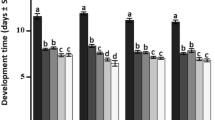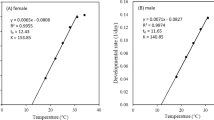Abstract
Laboratory experiments conducted at L: D = 16: 8 have shown that the observed temporal pattern of parasitization of the Angoumois grain moth, Sitotroga cerealella eggs by Trichogramma principium females represents a resultant of arrhythmic age-related trends and circadian rhythms. Most of females delayed parasitization. The daily number of females starting to parasitize was maximal on the first day of contact with the host and then gradually declined. Practically all of the females started parasitization during the photophase. Moreover, when the first contact with the host fell on the scotophase, the total cumulative percentage of females that started parasitization during four days of the experiment significantly decreased. Oviposition activities of parasitizing females also occurred mainly during photophase. However, under constant light, these circadian rhythms were damped out after one cycle. In addition, anticipatory period of darkness during photophase directly inhibited parasitization. This suggests that the observed rhythms can be easily modified by the direct environmental influence. Under natural conditions, such a flexible oviposition rhythm may be of advantage for these parasitoids enabling them to use any opportunity for reproduction. In biocontrol practice, the lability of parasitization rhythms may enable Trichogramma females to adapt immediately to any new light-dark regimes, although darkness may have negative effects on their efficiency.
Similar content being viewed by others
References
Abe, Y. and Tahara, M., “Daily Progeny Production and Thermal Influence on Development and Adult Longevity of the Leaf Miner Parasitoid, Gronotoma micromorpha (Hym., Eucoilidae),” J. Appl. Entomol. 127, 477–480 (2003).
Afonina, V.M., Greenberg, S.M., Chernyshev, V.B., Gavrilitsa, L.F., Lebedev, M.I., and Shlyakhtich, V.I., “Daily rhythms of Trichogramma,” in Proc. of the 1st All-Union Conference on Industrial Rearing of Insects (Moscow, 1986), pp. 27–28 [in Russian].
Alphen, J.J.M. van and Vet, L.E.M., “An Evolutionary Approach to Host Finding and Selection,” in Insect Parasitoids (London, 1986), pp. 23–61.
Bjorksten, T.A. and Hoffmann, A.A., “Effects of Preadult and Adult Experience on Host Acceptance in Choice and Non-choice Tests in Two Strains of Trichogramma,” Entomol. Exp. Appl. 76(1), 49–58 (1995).
Bjorksten, T.A., and Hoffmann, A.A., “Persistence of Experience Effects in the Parasitoid Trichogramma nr. Brassicae,” Ecol. Entomol. 23(2), 110–117 (1998).
Buleza, V.V., “Mechanisms of Host Search and Selection in Egg Parasitoids,” Zool. Zh. 64(9), 1309–1317 (1985).
Chernyshev, V.B., Insect Ecology (Moscow, 1996).
Degtyarev, B.G., Tsybul’skaya, G.N., Yanishevskaya, L.V., Koshevskaya, N.N., Dul’gerova, V.A. and Konverskaya, V.P., “Problems of Mass Rearing of Trichogramma and Its Hosts,” in Trichogramma in Plant Protection (Moscow, 1988), pp. 13–22 [in Russian].
Eisenstein, E.M. and Reep, R.L., “Behavioral and Cellular Studies of Learning and Memory in Insects,” in Comprehensive Insect Physiology, Biochemistry and Pharmacology (Oxford, 1985), Vol. 9, pp. 513–547.
Fleury, F. and Bouletreau, M., “Effect of Temporary Host Deprivation on the Reproductive Potential of Trichogramma brassicae,” Entomol. Exp. Appl. 68(3), 203–210 (1993).
Hoffmann, M.P., Ode, P.R., Walker, D.L., Gardner, J., Nouhuys, S., and Shelton, A.M., “Performance of Trichogramma ostriniae (Hymenoptera: Trichogrammatidae) Reared on Factitious Hosts, Including the Target Host, Ostrinia nubilalis (Lepidoptera: Crambidae),” Biol. Contr. 21(1), 1–10 (2001).
Kaiser, L., Pham-Delegue, M. H., Bakchine, E., and Masson, C., “Olfactory Responses of Trichogramma maidis Pint. et Voeg.: Effects of Chemical Cues and Behavioral Plasticity,” J. Insect. Behav. 2(5), 701–712 (1989).
Karpova, S.G., “The Role of Endogenous and Exogenous Factors in Regulation of Synchronous Emergence of Trichogramma embryophagum Hartig and T. principium Sug. et Sor. (Hymenoptera, Trichogrammatidae,” Entomol. Obozr. 85(2), 265–281 (2006) [Entomol. Rev. 86 (2), 252–263 (2006)].
Karpova, S.G. and Reznik, S.Ya., “Interaction of Exogenous Factors (Light and Temperature) in Their Influence on the Daily Pattern of Adult Eclosion in Trichogramma embryophagum (Hymenoptera: Trichogrammatidae),” Europ. J. Entomol. 99(4), 427–436 (2002).
Monje, J.C., Zebitz, C.P.W., and Ohnesorge, B., “Host and Host Age Preference of Trichogramma galloi and T. pretiosum (Hymenoptera: Trichogrammatidae) Reared on Different Hosts,” J. Econom. Entomol. 92(1), 97–103 (1999).
Olson, D.M. and Andow, D.A., “Larval Crowding and Adult Nutrition Effects on Longevity and Fecundity of Female Trichogramma nubilale Ertle & Davis (Hymenoptera: Trichogrammatidae),” Environ. Entomol. 27(2), 508–514 (1998).
Orphanides, G.M. and Gonzalez, D., “Importance of Light in the Biology of Trichogramma pretiosum,” Ann. Entomol. Soc. Amer. 63(6), 1734–1740 (1970).
Park, Y.-K., Lee, H.-P., Lee, K.-S., Han, M.-W., and Lee, J.O., “Effect of Photoperiod on Oviposition and Emergence of Egg Parasitoid, Trichogramma dendrolimi Matsumura (Hymenoptera, Trichogrammatidae),” Korean. J. Appl. Entomol. 38(2), 93–99 (1999).
Pivnick, K.A. and Labbe, E., “Daily Patterns of Activity of Females of the Orange Wheat Blossom Midge, Sitodiplosis mosellana (Gehin) (Diptera: Cecidomyiidae),” Can. Entomol. 125(4), 725–736 (1993).
Pompanon, F., Fouillet, P., Allemand, R., and Boulétreau, M., “Temporal Organization of Locomotor Activity in Trichogramma species (Hym. Trichogrammatidae): Variability and Relation to Efficiency of Parasitism,” Bull. Soc. Zool. France. 118(2), 141–148 (1993).
Pompanon, F., Fouillet, P., and Bouletreau, M., “Physiological and Genetic Factors as Sources of Variation in Locomotion and Activity Rhythm in a Parasitoid Wasp (Trichogramma brassicae),” Physiol. Entomol. 24(4), 346–357 (1999).
Reznik, S.Ya., “Learning in Food Selectivity in Insects,” Trudy Zool. Inst. Ross. Akad. Nauk 193, 5–72 (1993).
Reznik, S.Ya., “Intraspecific Variability of Parasitization Specificity in Insect Parasitoids by the Example of Trichogramma (Hymenoptera, Trichogrammatidae),” Entomol. Obozr. 74(3), 507–515 (1995) [in Russian].
Reznik, S.Ya., Voinovich, N.D., and Umarova, T.Ya., “Experimental Studies of Dynamics of the Percentage of Ovipositing Females and Their Fecundity in Successive Generations of Trichogramma (Hymenoptera, Trichogrammatidae),” Zool. Zh. 75(3), 375–382 (1996) [Entomol. Rev. 76 (1), 138–143 (1996)].
Reznik, S.Ya., Umarova, T.Ya., and Voinovich, N.D., “The Influence of Previous Host Age on Current Host Acceptance in Trichogramma,” Entomol. Exp. Appl. 82(2), 153–157 (1997).
Reznik, S.Ya., Voinovich, N.D., and Umarova, T.Ya., “Comparative Behavioral Analysis of Ovipositing Females and Females with Egg Retention in Trichogramma principium (Hymenoptera, Trichogrammatidae),” Entomol. Obozr. 80(3), 545–555 (2001) [Entomol. Rev. 81 (8), 895–903 (2001a)].
Reznik, S.Ya, Voinovich, N.D., and Umarova, T.Ya., “Long-term Egg Retention and Parasitization in Trichogramma principium (Hymenoptera, Trichogrammatidae),” J. Appl. Entomol. 125(4), 169–175 (2001b).
Reznik, S.Ya., Umarova, T.Ya., and Voinovich, N.D., “Egg Retention in Trichogramma (Hymenoptera: Chalcidoidea: Trichogrammatidae): Learning or Diapause?” Acta Soc. Zool. Bohem. 67(1), 25–33 (2003).
Ruberson, J.R., Tauber, M.J., and Tauber, C.A., “Reproductive Biology of Two Biotypes of Edovum puttleri, a Parasitoid of Colorado Potato Beetle Eggs,” Entomol. Exp. Appl. 46(3), 211–219 (1988).
Saunders, D.S., Insect Clocks (Amsterdam, 2002).
Sheeba, V., Chandrashekaran, M.K., Joshi, A., and Sharma, V.K., “A Case for Multiple Oscillators Controlling Different Circadian Rhythms in Drosophila melanogaster,” J. Insect Physiol. 47(100, 1217–1225 (2001).
Smith, S.M., “Biological Control with Trichogramma: Advances, Successes, and Potential of Their Use,” Ann. Rev. Entomol. 41, 375–406 (1996).
Steidle, J.L.M. and van Loon, J.J.A., “Chemoecology of Parasitoid and Predator Oviposition Behaviour,” in Chemoecology of Insect Eggs and Egg Deposition (Berlin, 2002), pp. 291–317.
Tavares, J. and Voegele, J., “Influence of the Phototropism over the Egg Laying Rhythm and Emergence of Three Trichogramma species (Hym., Trichogrammatidae),” Redia 74(3, App.), 309–314 (1991).
Tessmer, J.W., Meek, C.L., and Wright, V.L., “Circadian Patterns of Oviposition by Necrophilous Flies (Diptera: Calliphoridae) in Southern Louisiana,” Southwest. Entomol. 20(4), 439–445 (1995).
Vet, L.E.M. and Groenewold, A.W., “Semiochemicals and Learning in Parasitoids,” J. Chem. Ecol. 16(11), 3119–3135 (1990).
Vinson, S.B., “The General Host Selection Behavior by Parasitoid Hymenoptera and a Comparison of Initial Strategies Utilized by Larvaphagous and Oophagous Species,” Biological Control. 11(1), 79–96 (1998).
Zaslavski, V.A., Zinovjeva, K.B., Umarova, T.Ya., and Reznik, S.Ya., “Interaction of the Circadian Rhythm Synchronized by Photoperiod and Thermoperiod with Direct Influence of Light and Temperature as Factors Determining the Rhythm of Adult Eclosion in Two Species of Trichogramma (Hymenoptera, Trichogrammatidae),” Entomol. Obozr. 78(1), 3–14 (1999) [Entomol. Rev. 79 (1), 1–10 (1999].
Zhang, W.Q., Agamy, E., and Hassan, S.A., “Life-Table Characteristics of Four Candidate Species of the Genus Trichogramma to Control the Diamondback Moth Plutella xylostella (L.),” Zeit. Pflanzenkrank. Pflanzenschutz. 108(4), 413–418 (2001).
Author information
Authors and Affiliations
Additional information
Original Russian Text © S.Ya. Reznik, N.D. Voinovich, S.G. Karpova, 2009, published in Entomologicheskoe Obozrenie, 2009, Vol. 88, No. 1, pp. 16–28.
Rights and permissions
About this article
Cite this article
Reznik, S.Y., Voinovich, N.D. & Karpova, S.G. Daily rhythms in parasitization of the Angoumois grain moth Sitotroga cerealella Oliv. (Lepidoptera, Gelechiidae) eggs by the egg parasitoid Trichogramma principium Sug. et Sor. (Hymenoptera, Trichogrammatidae) females. Entmol. Rev. 89, 5–15 (2009). https://doi.org/10.1134/S0013873809010023
Received:
Published:
Issue Date:
DOI: https://doi.org/10.1134/S0013873809010023




